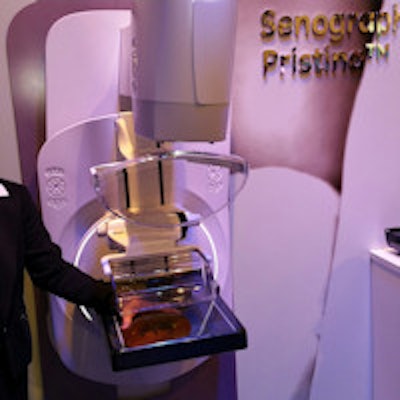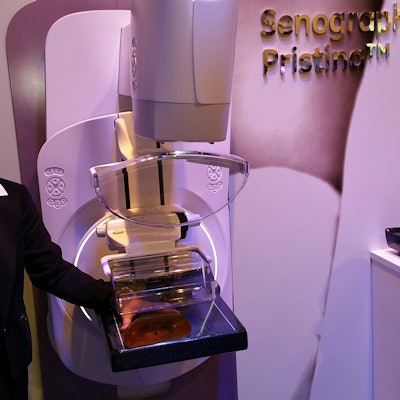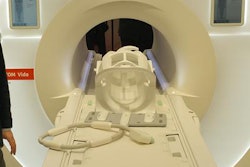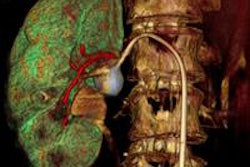
VIENNA - A new digital mammography system, a new CT scanner in its Revolution line, and new cardiac MRI software are among the product highlights for GE Healthcare at this week's ECR 2016 meeting.
In mammography, Senographe Pristina is a digital mammography system that offers a redesigned gantry compared to the company's current flagship Senographe system. Developed in collaboration with the Institut Gustave Roussy in France, as well as 25 other GE customer sites, Senographe Pristina is designed to make mammography more comfortable for patients and easier to perform for technologists.
For example, Pristina's bucky design is thinner and more rounded to reduce patient discomfort, and the system sports expanded space for technologists. The new system performs both 2D and 3D mammography with 100-micron pixel pitch and is based on the same digital detector and tube assembly as GE's flagship Senographe system. The unit will also support contrast-enhanced spectral mammography in the future.
 Senographe Pristina is a new mammography system being launched at ECR 2016.
Senographe Pristina is a new mammography system being launched at ECR 2016.Pristina is being shown at ECR 2016 as a work-in-progress, and GE expects to receive the CE Mark for Senographe Pristina in the second half of 2016; the company did not have an estimate of when it might receive U.S. regulatory clearance.
In other news in women's imaging, Senoiris is a new multimodality mammography workstation that the company is demonstrating. The computer performs a number of functions, such as image marking, reconstruction, and computer-aided detection. GE is also showing the Invenia automated breast ultrasound (ABUS) system.
In CT, GE is taking advantage of ECR 2016 to launch Revolution CT ES, which brings the company's Revolution technology to a more scalable platform, designed specifically for use in the emergency department. The system sports 8 cm of detector coverage and 0.28-second rotation, with an 80-cm bore.
Revolution CT ES is optimal for performing oncology, pediatric, and neurology studies, and users can upgrade to a system optimized for high-end cardiac exams. GE expects the scanner to be available by the end of 2016.
In the realm of radiation dose management, GE is highlighting the 2.0 release of its DoseWatch Explore software. The new version is a vendor-independent Web-based application that can track dose across an enterprise and produce reports. The 2.0 release tracks dose from radiotracers and also supports management of contrast.
In MRI, ViosWorks is a new scanning protocol designed to make it easier to perform powerful cardiac MRI scans. The sequence is designed to solve several challenges of cardiac MRI at once, providing users with automated quantitative data and deep learning expertise in a free-breathing scan of cardiac anatomy, function, and flow that takes less than 10 minutes to perform. Meanwhile, image processing is performed with a cloud-based architecture.
ViosWorks was developed in partnership with software developer Arterys, and GE expects it will be available in the summer of 2016 as part of the company's DV26.0 software release for users.
GE is also giving ECR 2016 attendees a look at the Signa Pioneer 3-tesla scanner first introduced at RSNA 2014 and which received the CE Mark in August 2015. GE is highlighting the scanner's ease of use and flexibility, as well as its field homogeneity and ultrahigh-efficiency gradient technology.
In the same vein, GE has announced a partnership with Circle Cardiovascular in which GE will offer Circle's cmr42 cardiac MRI software, which is available in both standalone and enterprise server configurations. The application offers a set of easy-to-use modules for viewing and analyzing cardiac MR images, with streamlined workflow, according to GE. The software is not yet ready for commercial release.
In interventional x-ray, GE is promoting the Assist package, which was shown at RSNA 2015 and is designed to help subspecialists perform complex endovascular procedures more easily. FlightPlan for Liver, which provides what GE calls directed workflow for liver embolization procedures, walks users step by step through studies performed on GE's Discovery IGS 740 angiography system. Another new application, Vessel Assist, is designed for procedures to clear chronic total occlusions, as well as transjugular intrahepatic portosystemic shunt (TIPS) procedures.
In ultrasound, GE is discussing the new 2.0 release of its Logiq E9 XDclear scanner platform. The release features a new system architecture and new transducers for scanning challenging body types. An organic light-emitting diode (OLED) monitor helps users see more detail, while tools like Volume Navigation with automated registration, contrast-enhanced ultrasound, and 2D shear-wave elastography are now easier to perform, according to the company. Also new is Logiq S8 XDclear, a shared-services scanner on the XDclear family.
In healthcare IT, the GE Health Cloud, launched at RSNA 2015, has been a major focus, as well as the Universal Viewer software for image review across an enterprise.
Finally, GE is observing the 10th anniversary of its VolumeRad chest tomosynthesis protocol for digital radiography studies.



















